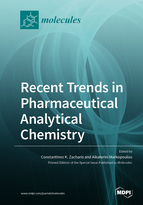Recent Trends in Pharmaceutical Analytical Chemistry
A special issue of Molecules (ISSN 1420-3049). This special issue belongs to the section "Analytical Chemistry".
Deadline for manuscript submissions: closed (31 May 2020) | Viewed by 41916
Special Issue Editors
Interests: pharmaceutical analytical chemistry; method development and validation; sample preparation (derivatization, microextraction, etc.); liquid and gas chromatography; capillary electrophoresis; mass spectrometry
Special Issues, Collections and Topics in MDPI journals
Interests: liquid and gas chromatography; mass spectrometry; FT-Raman; near-IR; chemometrics and implementation techniques; study and modeling of the retention mechanism of drugs on HPLC columns; drug-likeness by modeling and HPLC; bioanalysis; modern pharmaceutical formulations
Special Issues, Collections and Topics in MDPI journals
Special Issue Information
Dear Colleagues,
Modern analytical chemistry plays a vital role in pharmaceutical sciences. It provides identification and quantification data supporting drug discovery, purity of drug substances during its synthesis, pharmacokinetic studies, drug stability, elucidation of the drug metabolic pathways, drug-protein interactions, etc. New methodologies, state-of-the art instrumentation and materials, automated systems - offering precise and accurate analytical data – have become an important prerequisite in this field. Furthermore, chemometrics is a useful tool for the optimization of method parameters and also to identify and minimize the sources of variability that may lead to poor method robustness.
The present Special Issue will include review and full-length research articles covering the latest research trends and applications of Pharmaceutical Analytical Chemistry. Analytical scientists working on method development and validation, impurity profiling, pharmacokinetics, drug-protein/DNA interaction studies, bioanalysis, enantioseparation, etc are cordially invited to contribute a research or review article in this Special Issue. The degree of novelty and the significant of the research will be scrutinized prior to peer-reviewing process.
In the cases of review articles an additional brief (1-2 pages) description of the topic including a draft index is required. This preliminary step is essential to avoid overlapping of topics.
Dr. Constantinos K. Zacharis
Dr. Aikaterini Markopoulou
Guest Editors
Manuscript Submission Information
Manuscripts should be submitted online at www.mdpi.com by registering and logging in to this website. Once you are registered, click here to go to the submission form. Manuscripts can be submitted until the deadline. All submissions that pass pre-check are peer-reviewed. Accepted papers will be published continuously in the journal (as soon as accepted) and will be listed together on the special issue website. Research articles, review articles as well as short communications are invited. For planned papers, a title and short abstract (about 100 words) can be sent to the Editorial Office for announcement on this website.
Submitted manuscripts should not have been published previously, nor be under consideration for publication elsewhere (except conference proceedings papers). All manuscripts are thoroughly refereed through a single-blind peer-review process. A guide for authors and other relevant information for submission of manuscripts is available on the Instructions for Authors page. Molecules is an international peer-reviewed open access semimonthly journal published by MDPI.
Please visit the Instructions for Authors page before submitting a manuscript. The Article Processing Charge (APC) for publication in this open access journal is 2700 CHF (Swiss Francs). Submitted papers should be well formatted and use good English. Authors may use MDPI's English editing service prior to publication or during author revisions.
Keywords
- impurity profiling
- enantioseparation
- bioanalytical chemistry
- analytical quality by design (AQbD) - Chemometrics
- separation techniques (LC, GC, CE, SFC, LC x LC, etc)
- pharmacokinetics, Bioequivalence studies
- drug-protein/DNA binding studies
- automation
- quality control & stability
- sample preparation








